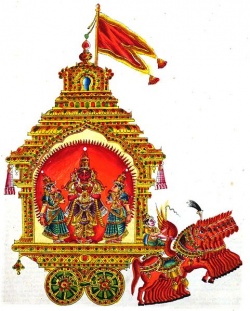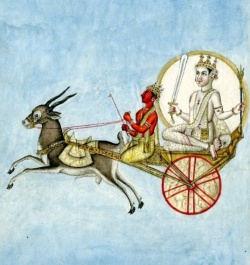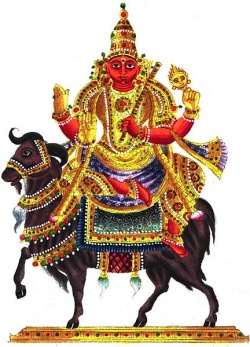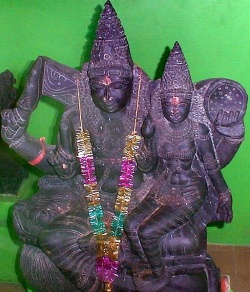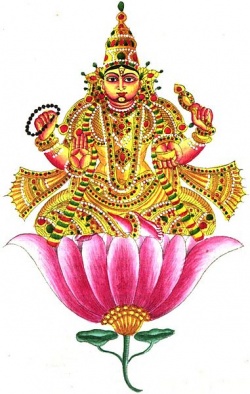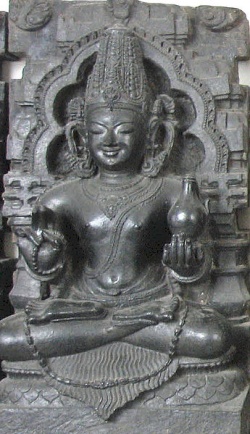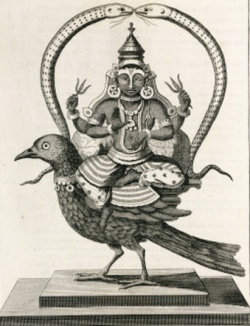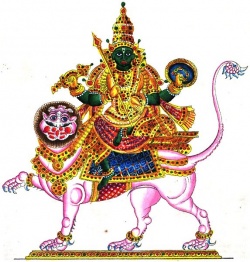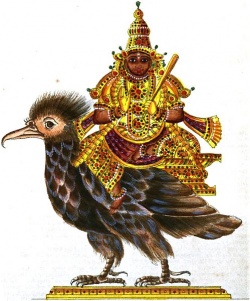Navagraha
Graha (from Sanskrit ग्रह gráha, —seizing, laying hold of, holding) (Tamil: கோள், kōḷ) is a 'cosmic influencer' on the living beings of mother Bhumidevi (Earth). In Hindu astrology, the Navagraha (Sanskrit: नवग्रह, nine seizers or nine influencers, Tamil: கோண்மீன், kōṉmīn, lit. Imperial stars) are some of these major influencers.
All the navagraha have relative movement with respect to the background of fixed stars in the zodiac. This includes the planets: Mars, Mercury, Jupiter, Venus, and Saturn, the Sun, the Moon, as well as positions in the sky, Rahu (north or ascending lunar node) and Ketu (south or descending lunar node).
According to some, Grahas are the "markers of influence" that point out the karmic influence on the behavior of living beings. They themselves are not causative elements but can be compared to traffic signs.
According to the astrological treatise Prasna Marga, there are many other spiritual entities called grahas or spirits. All (except the navagrahas) are said to have been born of the anger of Lord Shiva or Rudra. Most grahas are generally malefic in nature but there are a few that may be good. The book called The Puranic Encyclopedia, under the heading 'Graha Pinda', gives a list of such grahas (spirits or spiritual entities, etc.), that are said to afflict children, etc. Also in the same book in various places the names of spirits (grahas) are given, like 'Skhanda graha' that is said to cause miscarriage(s).
Astrology
Astrologers claim that Grahas influence the auras (energy bodies) and minds of beings connected to the Earth. Each Graha carries a specific energy quality, which is described in an allegorical form through its scriptural and astrological references. The energies of the Grahas are getting connected in a specific way to the individual auras of humans at the time they take their first breath in a given nativity. These energy connections remain with the natives of Earth as long as their current body lives. "The nine planets are transmitters of universal, archetypal energy. The qualities of each planet help to maintain the overall balance of polarities in both the macrocosmic and the microcosmic universe - as above, so below..."
Humans are also capable to tune themselves to the chosen energy of a specific Graha through Samyama with that Graha or its presiding deity. The effects of worship of specific deities are manifested accordingly to the layout of their relative energies in a given nativity of a worshiper in question, in particular depending on the Bhavas occupied by the respective Grahas. "The cosmic energy we always receive contains different energies coming from different celestial bodies." "When we repeatedly utter a Mantra we are tuning to a particular frequency and this frequency establishes a contact with the cosmic energy and drags it into our body and surroundings."
The idea of planets, stars and other celestial bodies being the living energy entities influencing the other beings of the Universe has cross-references in many ancient cultures and had become the background of numerous modern fiction works (like Solaris by Stanisław Lem, see also the movie with the same title).
The Navagraha denotes the nine celestial bodies (and not the nine planets as it is frequently errouneously translated) which are central to astrological calculations (and beliefs). The Navagrahas are: the sun, the moon, mars, mercury, jupiter, venus, saturn, and the two shadow planets Rahu and Ketu.
Surya
Surya is the chief, the solar deity, one of the Adityas, son of Kasyapa and one of his wives Aditi, Indra or Dyaus Pitar (depending on the version). He has hair and arms of gold. His chariot is pulled by seven horses, which represent the seven chakras. He presides as “Ravi” over “Ravi-var” or Sunday.
In Hindu religious literature, Surya is notably mentioned as the visible form of God that one can see every day. Furthermore, Shaivites and Vaishnavas often regard Surya as an aspect of Shiva and Vishnu, respectively. For example, the sun is called Surya Narayana by Vaishnavas. In Shaivite theology, Surya is said to be one of eight forms of Shiva, named the Astamurti.
He is said to be of Sattva Guna and represents the Soul, the King, highly placed persons or fathers. According to Hindu mythology, among the more renowned progenies of Surya are Shani (Saturn), Yama (God of Death) and Karna (Mahabharatha) fame. Invoking Gayatri Mantra or Aditya Hrudaya Mantra (Adityahridayam) are known to please the Sun God. The grain associated with the Sun is whole wheat and the number associated to the Surya is 1.
Chandra
Chandra is a lunar deity. Chandra (moon) is also known as Soma and identified with the Vedic Lunar deity Soma. He is described as young, beautiful, fair; two-armed and having in his hands a club and a lotus. He rides his chariot (the moon) across the sky every night, pulled by ten white horses or an antelope. He is connected with dew, and as such, is one of the gods of fertility. He is also called Nishadipati (Nisha=night; Adipathi=Lord) and Kshuparaka (one who illuminates the night). He as Soma, presides over Somvar or Monday. He is of Sattva Guna and represents the Mind, the Queen or Mother.
Mangala
Mangala is the god of Mars, the red planet. Mars is also called Angaraka (‘one who is red in colour’) or Bhauma (‘son of Bhumi’) in Sanskrit. He is the god of war and is celibate. He is considered the son of Prithvi or Bhumi, the Earth Goddess. He is the owner of the Aries and Scorpio signs, and a teacher of the occult sciences (Ruchaka Mahapurusha Yoga). He is of Tamas Guna in nature and represents Energetic action, confidence and ego. He is painted red or flame colour, four-armed, carrying a trident, club, lotus and a spear. His Vahana (mount) is a ram. He presides over ‘Mangal-var’ or Tuesday. There is a famous pilgrim place Mangalnath (in Ujjain,Madhya Pradesh, India). People who suffer from troubles related to Mangal Graha in their horoscope visit there on Tuesday. By worshiping & satisfying Mangal Graha, devotees get blessings & mercy of Mangal Devta. Only two temples of Mangal devata in India, of which one is in Amalner(Maharashtra) and another in Vaitheeswaran Kovil, Tamilnadu.
Budha
Budha is the god of the planet Mercury and the son of Chandra (the moon) with Tara (Taraka). He is also the god of merchandise and protector of merchants. He is of Rajas Guna and represents Communication.
He is represented as being mild, eloquent and of greenish colour. He is represented holding a scimitar, a club and a shield, riding a winged lion in Ramghur temple. In other illustrations, he holds a sceptre and lotus and rides a carpet or an eagle or a chariot drawn by lions.
Budha presides over ‘Budh-var’ or Wednesday. In modern Telugu Hindi, Bengali, Marathi, Kannada and Gujarati, Wednesday is called Budhvar; in Tamil and Malayalam it is Budhan.
Brihaspati
Brihaspati is the Guru of Devas, personification of piety and religion, the chief offerer of prayers and sacrifices, represented as the Purohita of the gods with whom he intercedes for men. He is the Lord of planet Jupiter. He is of Sattva Guna and represents knowledge and teaching. He is often known simply as “Guru”.
According to Hindu scriptures, he is the guru of the Devas and the arch-nemesis of Shukracharya, the guru of the Danavas. He is also known Guru, the god of wisdom and eloquence, to whom various works are ascribed, such as the “atheistic” Barhaspatya sutras.
His Tattva or element is Akasha or ether, and his direction is north-east. He is described of yellow or golden colour and holding a stick, a lotus and his beads. He presides over ‘Guru-var’, Brihaspativar or Thursday.
Shukra
Shukra, Sanskrit for “clear, pure” or “brightness, clearness”, is the name the son of Bhrigu and Ushana, and preceptor of the Daityas, and the guru of the Asuras, identified with the planet Venus (Shukracharya). He presides over ‘Shukra-var’ or Friday. He is Rajas in nature and represents wealth, pleasure and reproduction.
He is of white complexion, middle-aged and of agreeable countenance. He is described variously mounted, on a camel or a horse or a crocodile. He holds a stick, beads and a lotus and sometimes a bow and arrow.
In Astrology, there is a dasha or planetary period known as Shukra Dasha which remains active in a person’s horoscope for 20 years. This dasha is believed to give more wealth, fortune and luxury to one’s living if a person has Shukra positioned well in his horoscope as well as Shukra being an important benefic planet in his/her horoscope.
Shani
Shani is embodied in the planet Saturn, and is the Lord of Saturday. The origin of word Shani (शनि) comes from the following: Shanaye Kramati Sa: (शनये क्रमति सः) i.e. the one who moves slowly. Saturn takes about 30 years to revolve around the Sun, thus it moves slowly compared to other planets, thus the Sanskrit name शनि. Shani is actually a demi-god and is a son of Surya (the Hindu Sun God) and surya’s wife Chhaya. It is said that when he opened his eyes as a baby for the very first time, the sun went into an eclipse, which clearly denotes the impact of Shani on astrological charts (horoscope).
His Tattva or element is air, and his direction is west. He is Tamas in nature and represents learning the hard way, Career and Longevity. He is depicted dark in colour, clothed in black; holding a sword, arrows and two daggers and variously mounted on a black crow or a raven. He presides over ‘Shani-var’ or Saturday.
Rahu
Rahu is God of the Ascending / North lunar node. Rahu is the head of the demonic snake that swallows the sun or the moon causing eclipses, according to Hindu scriptures. He is depicted in art as a dragon with no body riding a chariot drawn by eight black horses. He is a Tamas Asura who does his best to plunge any area of one’s life he controls into chaos. The rahu kala is considered inauspicious.
According to legend, during the Samudra manthan, the asura Rahu drank some of the divine nectar. But before the nectar could pass his throat, Mohini (the female avatar of Vishnu) cut off his head. The head, however, remained immortal and is called Rahu, while the rest of the body became [[Wikipedia:Ketu (mythology)|Ketu]. It is believed that this immortal head occasionally swallows the sun or the moon, causing eclipses. Then, the sun or moon passes through the opening at the neck, ending the eclipse.
Ketu
Ketu is the Lord of Descending/South lunar node. Ketu is generally referred to as a “shadow” planet. He is considered as Tail of the Demon Snake. It is believed to have a tremendous impact on human lives and also the whole creation. In some special circumstances it helps someone achieve the zenith of fame. He is Tamas in nature and represents supernatural influences.
Astronomically, Ketu and Rahu denote the points of intersection of the paths of the Sun and the Moon as they move on the celestial sphere. Therefore, Rahu and Ketu are respectively called the north and the south lunar nodes. The fact that eclipses occur when the Sun and the Moon are at one of these points, gives rise to the story of the swallowing of the Sun and the Moon.
Associated characters
Each of the graha has associations with various characters, such as colors, metals, etc. The following table gives the most important associations:
| Character | Surya Dev (sun) | Chandra (Moon) | Mangala (Mars) | Budha (Mercury) |
|---|---|---|---|---|
| Consort | Sangya & Chaaya | Rohini | Shaktidevi | Ila |
| Color | Gold | Silver | Red | Green |
| Gender Associated | Male | Male | Male | Male |
| Element | Fire | Water | Fire | Earth |
| God | Agni | Varuna | Subramanya | Vishnu |
| Pratyadi Devataa | Rudra | Gowri | Murugan | Vishnu |
| Metal | Gold | Silver | Copper | Zinc |
| Gemstone | Ruby | Pearl/Moonstone | Red Coral | Emerald |
| Body Part | Bone | Blood | Marrow | Skin |
| Taste | Pungent | Salt | Acid | Mixed |
| Food | Wheat | Rice | Pigeon pea | Mung bean |
| Season | Summer | Winter | Summer | Autumn |
| Direction | East | North West | South | North |
| Day | Sunday | Monday | Tuesday | Wednesday |
| Tone (Svara) | Ga | Ma | Re | Sa |
| Character | Guru (Jupiter) | Shukra (Venus) | Shani (Saturn) | Rahu (north node) | Ketu (south node) |
|---|---|---|---|---|---|
| Consort | Tara | Sukirthi & Urjaswathi | Neeladevi | Simhi | Chitralekha |
| Color | Yellow | White/Yellow | Black/Blue | Dark Blue | Smoky Grey |
| Gender Associated | Male | Female | Neutral | Male | Neutral |
| Element | Ether | Water | Air | Air | Earth |
| God | Indra | Indrani | Brahma | Nirriti | Ganesha |
| Pratyadi Devataa | Brahma | Indra | Yama | Durga | Chitragupta |
| Metal | Gold | Silver | Iron | Lead | Mercury |
| Gemstone | Yellow Sapphire | Diamond | Blue Sapphire | Hessonite | Cat's Eye |
| Body Part | Brain | Semen | Muscles | Head | Skin |
| Taste | Sweet | Sour | Astringent | - | - |
| Food | Chickpea | kidney beans | Sesame | Urad (bean) | Horse gram |
| Season | Winter | Spring | All Seasons | - | - |
| Direction | North East | South East | West | South West | - |
| Day | Thursday | Friday | Saturday | Saturday | -Tuesday |
| Tone (Svara) | Dha | Ni | Pa | - | - |
Positioning in Hindu custom
As per Hindu customs, the Navagraha are typically placed in a single square with the Sun (Surya) in the center and the other deities surrounding Surya; no two of them are made to face each other. In South India, their images are generally found in all important Saiva temples. They are invariably placed in a separate hall, on a pedestal of about three feet in height, usually to the north-east of the sanctum sanctorum.
There are 2 kinds of installation of the planets when arranged in this fashion, known as Agama Prathishta and Vaidika Prathishta.
In Agama Prathishta, Surya occupies the central place, Chandra on Surya’s east, Budha on his south, Brihaspati on his west, Shukra on his north, Mangala on his south-east, Shani on his south-west, Rahu on north-west and Ketu in the north-east. Temples such as Suryanar temple, Tiruvidadaimarudur, Tiruvaiyaru and Tirucchirappalli follow this system.
 Rahu |
 Shukra |
 Ketu |
 Brihaspati |
 Surya |
 Chandra |
 Shani |
 Budha |
 Mangal |
In Vaidika Pradishta, Surya is still in the centre, but Shukra is in the east, Mangala in the south, Shani in the west, Brihaspati in the north, Chandra in the south-east, Rahu in the south-west, Ketu in the north-west and Budha in the north-east.
 Ketu |
 Brihaspati |
 Budha |
 Shani |
 Surya |
 Shukra |
 Rahu |
 Mangal |
 Chandra |
Other temples install the Navagrahas in other arrangements.
In Ramanathapuram district, in a place called Navapashana, nine stone slabs are worshipped as the Navagraha. In temples like Tirukuvalai and Tiruvarur, the nine planets stand in a straight line. In Thirupanjali temple, they are represented by nine holes in a stone.
The Gangaikonda Cholapuram temple boasts a unique structure wherein the nine grahas are installed in a single stone. Surya is prominently displayed in this structure with seven horses in a chariot with two wheels and a charioteer. The other eight grahas are placed in eight directions with the sun in the centre.
At Agasthiyar Temple Chennai Pondy Bazaar a totally different form of position is done with Sun at the elevated centre and the remaining planets in an octogonal structure. This is called Agasthiyar Kattu (the form promoted by Sage Agasthiya).
In Indian Astrology movement of the Navagrahas is considered to have a major role in influencing the fortunes of any individual. In order to mitigate the negative effects of a planet which is debilated in the birth chart or to provide more potency to a planet that is in an exalted state, believers undertake pilgrimage to designated Navagraha temples.
Traditional Hindu astrologers castes in India are known to be major experts of Navagraha, many people would approach a Hindu astrologer when they have problems and ask them on how to overcome them by performing certain rituals which involve worship of Navagraha to overcome ill effects. People of the Kaniyar (Ganaka) caste of south India, particularly in Kerala state and the Graha Bipra, Acharya or Ganak Brahmins in the north eastern states of India have custom of high preference for worshiping planets and sun. They are believed to be the descendants of Sakaldwipiya Brahmins, who were once sun worshipers by nature.
